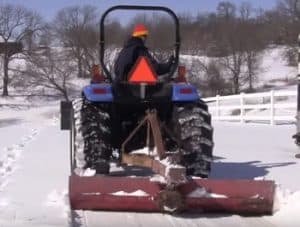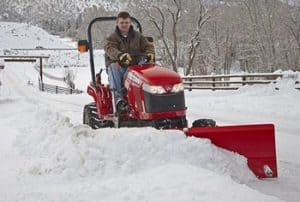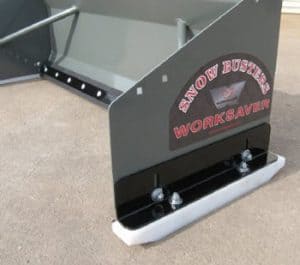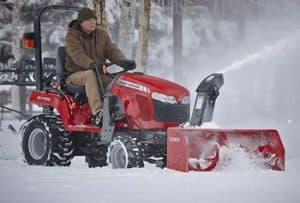It’s getting to be that time, when snow removal is no longer a summer fantasy. Think your compact tractor is ready for a long winter nap now that your summer and fall chores are finished? Actually, no. Your compact tractor can be ready handle snow all winter long. Here’s what you need to know.
Best Attachments for Snow Removal
Go out and take a look at your machine. How is it currently outfitted? If you’ve already got a front end loader on the tractor, you can easily swap that out for a front snow blade and be ready for those fat white flakes to start falling. A front end hitch means you can probably attach a snow blower.
If you have a rear three-point hitch, then you can choose from a variety of rear blade and blower attachment options.
Front End or Rear End Attachment: How to Choose
Let’s take a look at the available attachments and assess the benefits and drawback of each of them. Once you’ve determined the task the tractor will have to do, choosing the right piece of equipment is often a matter of personal preference.
Front End Loader for Snow Removal
 If your tractor has one, you probably use the front end loader all through the warmer seasons to perform a multitude of tasks. And you can keep the front end loader busy all winter, too, using it for snow removal and moving your woodpile. However, keep in mind that the loader can’t angle. That means that when used for removing snow, the bucket will fill up and then start spilling snow over the sides and top. You’ll have to stop fairly often and raise the bucket to dump the load. Then you’ll have to lower it again for more snow loads. And unfortunately, front end loader buckets are known for gouging long strips of sod from lawn, and damaging paved surfaces, even when you work slowly and with extra care.
If your tractor has one, you probably use the front end loader all through the warmer seasons to perform a multitude of tasks. And you can keep the front end loader busy all winter, too, using it for snow removal and moving your woodpile. However, keep in mind that the loader can’t angle. That means that when used for removing snow, the bucket will fill up and then start spilling snow over the sides and top. You’ll have to stop fairly often and raise the bucket to dump the load. Then you’ll have to lower it again for more snow loads. And unfortunately, front end loader buckets are known for gouging long strips of sod from lawn, and damaging paved surfaces, even when you work slowly and with extra care.
But here’s the good news: Mount a front plow to your front end loader and you can up your snow removal game immediately. Whether you chooses as simple clamp-on unit, or one that can be hydraulically angled, adding a snow plow will make your snow clearing efforts easier and far more efficient. Planning to apply salt or sand as well? Add a rear spreader and your plowed drive will be far less slippery in no time at all.
Blades for Snow Removal
For decades now, tractor owners have added front- and rear-mount blades to tackle their snow. Blades are simple and easy to use. Of course, in dry weather, you can use the blade for a number of other purposes, from grading your gravel road to scraping flat areas where you need them on your property.
A variety of sizes, and mounting options let you choose what you prefer. Some blades are front-mount with two-lever quick-attach. Some come with tractor-specific mounts, sub-frame mounts, or a three-point hitch. Blade styles vary from a fixed blade, angling blade, trip blade, trip-edge blade or a six-way blade. Ask your dealer for more details if you need information to help you make the best choice.
Three-Point Blades
 Three-point blades are often used for snow removal, and work just as well moving dirt or grading roads. Since they don’t require an additional hitch, the rear blade is more economical than a front blade. A rear-mounted blade can be used both moving forward or backward, however when traveling forward, snow is packed down by the tractor prior to removal by the blade. On the other hand, pushing the snow as you travel backwards means the blade will need to be rotated 180 degrees. And sometimes the pushing action is hard on the blade, occasionally resulting in damage.
Three-point blades are often used for snow removal, and work just as well moving dirt or grading roads. Since they don’t require an additional hitch, the rear blade is more economical than a front blade. A rear-mounted blade can be used both moving forward or backward, however when traveling forward, snow is packed down by the tractor prior to removal by the blade. On the other hand, pushing the snow as you travel backwards means the blade will need to be rotated 180 degrees. And sometimes the pushing action is hard on the blade, occasionally resulting in damage.
A quality three-point blade for your compact tractor can start as low as $600, and will mostly like offer hydraulic angling for that price. Hydraulic angling requires a power behind outlet and hydraulics incorporated into the rear blade assembly. You can find cheaper blades, but they won’t angle, and you’ll be climbing off the tractor to manually adjust the angle. And you’ll want to consider this: using a rear blade demands a good deal of rearward neck craning. A front-mounted blade avoids that problem.
Front-Mounted Blades
 These popular snow removal tools are easier to use than a rear blade. And with a two-lever hitch, they are easier to install and uninstall than a three-point rear blade. Plus, using a front blade frees up your tractor’s three-point for a salt or sand spreader. Driving forward to remove the snow is the largest benefit of a front-mounted blade. Unfortunately, though, some manufacturers require a sub-frame for blade hookup, which means you’ll need to remove the loader. The subframes are cumbersome, and often expensive. And your bucket will not be available for use until you pull the front blade off again.
These popular snow removal tools are easier to use than a rear blade. And with a two-lever hitch, they are easier to install and uninstall than a three-point rear blade. Plus, using a front blade frees up your tractor’s three-point for a salt or sand spreader. Driving forward to remove the snow is the largest benefit of a front-mounted blade. Unfortunately, though, some manufacturers require a sub-frame for blade hookup, which means you’ll need to remove the loader. The subframes are cumbersome, and often expensive. And your bucket will not be available for use until you pull the front blade off again.
Front blades come with features like moldboards or edges that trip and angling options. Some models transform into V-blades (also known as six-way blades.) With hydraulic power, functions such as raising and lowering the blade and angling become possible.
With all these extras, you’re going to be paying a good deal more than you would for the three-point blade. A quality front-mount blade with hydraulic capabilities can start at around $2,000.
Remember, though, that an inexpensive front blade generally won’t angle and will require some effort to be raised and lowered. Moving up the tractor chain where hydraulic power is available.
Snow Pushers
 The simplest and most economical tool for snow removal is a snow pusher. Basically, the snow pusher is a large box that captures the snow as you push forward. It holds a lot more snow than the tractor bucket can, and you can order it with a steel or rubber composite scraper edge on the bottom of the moldboard. Rubber edges flex and pass over obstructions under most conditions, offering protection to the road surface below. You may also run across snow pushes with a steel edge option and trip mechanism that serves the same purpose.
The simplest and most economical tool for snow removal is a snow pusher. Basically, the snow pusher is a large box that captures the snow as you push forward. It holds a lot more snow than the tractor bucket can, and you can order it with a steel or rubber composite scraper edge on the bottom of the moldboard. Rubber edges flex and pass over obstructions under most conditions, offering protection to the road surface below. You may also run across snow pushes with a steel edge option and trip mechanism that serves the same purpose.
Snow pushers do not windrow snow like traditional angled blades do. Instead, they push straight forward to pile snow at a chosen location. Small pushers start at about 4 ft wide , while large commercial pushers can be 30 ft wide or more. Compact tractor models run in the 4- to 8-ft range, with moldboards 18 to 30 in. high and start around $600. If you choose to add optional equipment like pull-back blades that rotate the box 90 degrees, or abrasion-resistant skid shoes, you’ll probably spend upwards of $1,000.
Snow Blowers for Snow Removal
 If you’re looking for the ultimate in snow removal, add a snow blower to your compact tractor. Choose front or rear mount. With a re rear-mount snow blower, you’ll have to drive in reverse to move the snow, or use a pull-type snow blower and drive over the snow before you remove it. Front-mount blowers often require expensive sub-frames and a mid-mount power take-off (PTO). Because of the restrictions with the hydraulic capabilities of tractors, front-loader mount blowers require hydraulic power packs that can make the package considerably less affordable. The bucket and/or loader must be removed to use a front snow blower, adding time and effort to the task.
If you’re looking for the ultimate in snow removal, add a snow blower to your compact tractor. Choose front or rear mount. With a re rear-mount snow blower, you’ll have to drive in reverse to move the snow, or use a pull-type snow blower and drive over the snow before you remove it. Front-mount blowers often require expensive sub-frames and a mid-mount power take-off (PTO). Because of the restrictions with the hydraulic capabilities of tractors, front-loader mount blowers require hydraulic power packs that can make the package considerably less affordable. The bucket and/or loader must be removed to use a front snow blower, adding time and effort to the task.
Three-point snow blowers start around $2,500 and can run up to $4,500. Front-mount snow blowers with the required sub-frame can begin at more than $4,000.
However, if that’s not a strain on your pocket, there are lots of advantages associated with front-mounted snow blowers. You’ll be able to shoot snow over embankments, cut through deep snowfalls, and adjust chute direction to counter crosswinds.

Good job, Mike! Another snow removal item some tractor operators in Alaska use is a self-powered snow blower that attaches to the loader quick-connect. These attachments have a separate engine on the snow blower that drives the snow blower augers. Chutes and deflector (horizontal and vertical angle controls) can be either electric or hydraulic. One drawback to self-powered blowers is the engines typically use gasoline, so if you have a diesel tractor, there’s another fuel you’ll need to manage. But, it does enable a front-mounted snow blower on a tractor without a subframe. One company that I’ve seen offering self-powered and tractor (or 4-wheeler) -mounted snowblowers is Bercomac. They are based in Canada, and they really know how to move snow in Canada!
Love your Ask Tractor Mike website. I’ve found your safety videos to be exceptional, and you’ve done a terrific job several other tractor topics. Thank you from Alaska!
I slit a one to one and a half inch steel pipe and fit it over the cutting edge of the front end loader bucket. This prevents most of the scalping of sod, gouging up gravel, or scarring pavement. Still allows you to scoop up all but a thin coating of snow. Doesn’t eliminate the other limitations of using a FEL for snow removal, but they tend to be available when the snow flys. Slitting the pipe can be done with a mill, plasma arc cutter, or, ( if you are patient and talented) you can use a circular saw with a metal cutting friction blade. I use a mill, heat and bend a 1 inch by 1/8 th inch strap around the pipe into a tight U and bolt to the FEL, need two straps, right and left.
Nice summary. Great information to help me make decisions
Looking for 3pt snow blade 6′ to 7′ for a ford 4000. Heavy duty
Edge Tamers work great on the front end loader to prevent gouging and give a smooth feather as long as you want.. I like going forward with the rear plade. Packing down the snow as you drive over it doesn’t bother it as long as you have shoes on the blade and it’s set at the right height.
I like to use a car wax spray on the loader and the blead to make the snow less sticky.
I have a 3 pt snowthrower, but only use it when caught by a very heavy storm. Going in reverse and dealing with the wind is a nuisance. I’d rather get out ever few hours, plow the quarter mile or so I need to plow with the rear blade, and just do it before it gets too deep.
Blade works nice up to about 8 inches at a time, passable if it’s a foot, but that’s about the limit.
[…] A rear-mounted blade can be used both moving forward or backward, however when traveling forward, snow is packed down by the tractor prior to removal by the blade. On the other hand, pushing the snow as you travel backwards means the blade will need to be rotated 180 degrees. via […]
Do you have a light weight rear blade that i can use on my john deere x739 I added hydraulics on the back of rider I would like to get a 5 or maybe 6 foot blade to remove snow I currently have a black boar blade its maybe 40 inches wide and really heavy to put on each time, not sure if there might be a hard plastic blade? I have like a 2×2 inch receiver that blade slides into.
George,
I’m not going to be able to give you any good advice, we don’t get enough winter weather where I live for me to have any experience with snow removal equipment. All I’ve ever used, or sold, for snow removal, was a simple blade.
Sorry to be no help!
-Mike